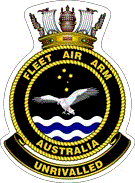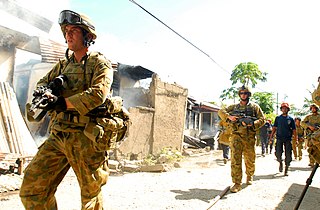
The Australian Defence Force (ADF) is the military organisation responsible for the defence of the Commonwealth of Australia and its national interests. It has three branches: the Royal Australian Navy (RAN), Australian Army and the Royal Australian Air Force (RAAF). The ADF has a strength of just over 90,000 personnel and is supported by the Department of Defence and several other civilian agencies.

The Australian contribution to the war in Afghanistan has been known as Operation Slipper (2001–2014) and Operation Highroad (2015-2021).
The Meritorious Unit Citation is a collective group decoration awarded to members of Australian military units. It recognises sustained outstanding service in warlike operations. The Meritorious Unit Citation was created in 1991, along with the Unit Citation for Gallantry.

HMAS Parramatta is an Anzac-class frigate of the Royal Australian Navy (RAN). One of ten warships built for the RAN and Royal New Zealand Navy (RNZN) based on the MEKO 200 design, Parramatta was laid down in 1999, launched in 2003, and commissioned into the RAN in 2003. During her career, the frigate has been deployed to the Middle East on several occasions. In early 2015, Parramatta was docked to undergo the Anti-Ship Missile Defence (ASMD) upgrade. She completed these upgrades in April 2016.

HMAS Arunta is an Anzac-class frigate of the Royal Australian Navy (RAN). The ship, named for the Arrernte people, was laid down in 1995 and commissioned in 1998. Since entering service, Arunta has performed a wide range of duties, including border protection patrols in northern Australian waters, and several deployments to the Persian Gulf.

HMAS Ballarat is an Anzac-class frigate of the Royal Australian Navy (RAN). The frigate was laid down in 2000 and commissioned into the RAN in mid-2004. Since entering service, Ballarat has been involved in border protection as part of Operation Relex II, was deployed to the Gulf for Operation Catalyst, and was one of the two ships involved in the Operation Northern Trident 2009 round-the-world voyage. Ballarat has undergone the Anti-Ship Missile Defence (ASMD) upgrade, completing in 2015.

HMAS Melbourne was an Adelaide-class guided-missile frigate of the Royal Australian Navy, which entered service in 1992. Melbourne has been deployed to the Persian Gulf on several occasions, and served as part of the INTERFET peacekeeping taskforce in 2000. On 26 October 2019, Melbourne was decommissioned from the RAN, subsequently being transferred to Chile. The ship was commissioned into the Chilean Navy as Almirante Latorre on 15 April 2020.

No. 5 Squadron RNZAF is a maritime patrol and anti-submarine warfare squadron of the Royal New Zealand Air Force. It operates the Boeing P-8 Poseidon from RNZAF Base Ohakea. The squadron was formed during the Second World War and has since been in continuous operation. A number of maritime patrol aircraft have been operated by the squadron over the course of its existence including the Short Singapore, Consolidated PBY Catalina, Short Sunderland and the Lockheed P-3 Orion.

The Fleet Air Arm (FAA), known formerly as the Australian Navy Aviation Group, is the division of the Royal Australian Navy (RAN) responsible for the operation of aircraft. The FAA was founded in 1947 following the purchase of two aircraft carriers from the Royal Navy. FAA personnel fought in the Korean War and the Vietnam War, and participated in later conflicts and operations from host warships.
The Royal Australian Navy, although a significant force in the Asia-Pacific region, is nonetheless classed as a medium-sized navy. Its fleet is based around two main types of surface combatant, with limited global deployment and air power capability. However, in 2009, a white paper, Defending Australia in the Asia Pacific Century: Force 2030, was produced by the Australian government which set out a programme of defence spending that will see significant improvements to the RAN's fleet and capabilities.

No. 11 Squadron is a Royal Australian Air Force (RAAF) maritime patrol squadron based at RAAF Base Edinburgh, South Australia. It was formed in 1939 and has seen active service in World War II, East Timor, the War on Terrorism and the 2003 Gulf War. The squadron became known to the public through its participation in the Great Southern Ocean rescues of wrecked sailors, such as Tony Bullimore and Isabelle Autissier.

The 5th Aviation Regiment is an Australian Army aviation unit. Formed in 1987 after the Army took over responsibility for operating helicopters from the Royal Australian Air Force, the regiment is based at RAAF Base Townsville, in Queensland. It currently forms part of the 16th (Aviation) Brigade and it operates the majority of the Army's transport helicopters. Throughout its existence, the regiment has been deployed overseas numerous times, supporting both peacekeeping and warlike operations. Since its formation elements of the regiment have made operational deployments to Cambodia, Papua New Guinea, East Timor, Iraq, Indonesia and Pakistan.

Australia was a member of the international coalition which contributed military forces to the 1991 Gulf War, also known as Operation Desert Storm. More than 1,800 Australian Defence Force (ADF) personnel were deployed to the Persian Gulf from August 1990 to September 1991, while contingents from the Royal Australian Navy circulated through the region in support of the sanctions against Iraq until November 2001. In August 1990, two frigates HMAS Adelaide and HMAS Darwin and the replenishment ship HMAS Success left for the Persian Gulf. HMAS Success had no air defences, so the Army 16th Air Defence Regiment was embarked. On 3 December 1990, HMAS Brisbane and HMAS Sydney (IV) relieved HMAS Adelaide and HMAS Darwin. On 26 January 1991, HMAS Westralia replaced HMAS Success. A Navy clearance diving team was also deployed for explosive ordnance disposal and demolition tasks. Australian ships were in danger of sea mines and possible air attacks. In a number of recorded incidents, HMAS Brisbane encountered free floating mines, on one occasion narrowly avoiding a collision. Both HMA Ships Brisbane and Sydney encountered significant air threat warnings from Iran and Iraq throughout the initial period of the commencement of the Desert Storm Campaign. The detection of land based Silkworm anti-ship missiles from Iran throughout the campaign also added to the challenges for both crews as well as the multi-national Naval Forces.

Operation Astute was an Australian-led military deployment to East Timor to quell unrest and return stability in the 2006 East Timor crisis. It was headed by Brigadier Bill Sowry, and commenced on 25 May 2006 under the command of Brigadier Michael Slater. The operation was established at the request of East Timor's government, and continued under an understanding reached between Australia, East Timor, and the United Nations, with the United Nations Integrated Mission in East Timor supporting and helping to develop East Timor's police force. Other countries deploying soldiers to East Timor include Malaysia, New Zealand and East Timor's former colonial power Portugal, operating under independent command.

No. 92 Wing is the maritime patrol wing of the Royal Australian Air Force. Headquartered at RAAF Base Edinburgh, 92WG is part of the Surveillance and Response Group, and with the transitioning of No. 10 Squadron to 42 Wing with effect 1 May 2019 - 92 Wing currently comprises two squadrons - No. 11 Squadron for operational duty, and No. 292 Squadron for training. The wing also has a detachment headquarters at RMAF Base Butterworth in Malaysia. 92WG operates 12 P-8A Poseidon maritime patrol aircraft. The P-8A is multi-role platform, capable of F2T2EA. Its roles include anti-submarine and anti-surface surveillance and warfare, for which the aircraft are equipped with MK54 torpedoes and Harpoon anti shipping missiles. It is also responsible for long range intelligence, surveillance, reconnaissance and maritime attack missions, Naval support and search and survivor supply missions. The Australian Maritime search area of responsibility constitutes approximately 11% of the Earth's surface, the largest area of responsibility for any single country.
The British Commonwealth Far East Strategic Reserve was a joint military force of the British, Australian, and New Zealand armed forces. Created in the 1950s and based in Malaya, the FESR was conceived as a forward defence point for Australia and New Zealand, while protecting Commonwealth interests in the Southeast Asian region from both internal and external communist threats. The FESR was made up of an infantry brigade and an aircraft carrier group, supported by squadrons of aircraft.

The order of battle of Australian forces during the Korean War consisted of one, and later two infantry battalions, naval forces of one aircraft carrier, two destroyers, and one frigate, as well as air forces consisting of one fighter squadron and one transport squadron. The first forces were committed in July 1950 from units based in Japan as part of the British Commonwealth Occupation Force, with Australia being the first UN member nation after the United States to commit elements from all three services. A total of 17,808 Australians served during the Korean War, including 1,193 members of the Royal Australian Air Force (RAAF), 5,771 from the Royal Australian Navy (RAN), and 10,844 from the Australian Army, with casualties including 341 killed and 1,216 wounded. Australian forces remained following the end of hostilities, with the last units finally departing in 1956.

Vice Admiral Raymond James Griggs, is an Australian senior public servant and a former senior officer in the Royal Australian Navy. He served as Chief of Navy from June 2011 to June 2014, before being appointed Vice Chief of the Defence Force until his transfer to the reserve in July 2018.
Vice Admiral Jonathan Dallas Mead, is a senior officer in the Royal Australian Navy. He joined the navy via the Royal Australian Naval College at HMAS Creswell in 1984, and spent his early career with the Clearance Diving Branch before training as a Principal Warfare Officer. He captained HMAS Parramatta on operations in the Persian Gulf from 2006 to 2007 during the Iraq War and commanded Combined Task Force 150, overseeing maritime counter-terrorism operations around the Arabian Peninsula and Horn of Africa, from 2011 to 2012. He served as Head of Navy Capability from 2015 to 2017, Commander Australian Fleet from 2018 to 2020, Chief of Joint Capabilities from 2020 to 2021, and was appointed Chief of the Nuclear-Powered Submarine Task Force in September 2021.














